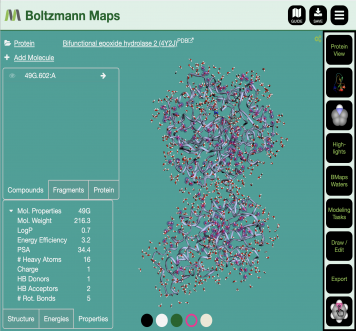Product Benefits
Largest Repository of Simulated Fragment Binding Data

With the BMaps web app, we want users to get answers fast. Users should access the broadest set of compound modification options possible from fragment maps to improve their designs.
Thus, fragment maps, hotspots, and water maps for many popular proteins are precomputed. The protein structure model is optimized for simulation, molecular components such as cofactors, ions, or inhibitors are identified, and forcefield parameters are automatically assigned.
We have currently simulated almost 500 proteins that are targets of pharmaceutical and investor interest with over 100 chemical fragments on each target. To our knowledge, no other group has produced a quantitatively rigorous, fragment and water binding dataset of this magnitude, available to the public.
Affordable, Accurate Water Maps
Water maps in BMaps help users understand the impact of water molecules on the binding of their compounds to a protein. To get an accurate picture, the configuration of waters on a protein needs to be reliably discovered and water binding sites rigorously ranked by affinity. It has previously been very expensive to achieve this.
Water maps generated by Grand Canonical Monte Carlo simulations [link: Boltzmann fragment maps] are considered among the best descriptions of water binding. The BMaps web app now makes such water maps available to a broad audience at an unprecedented low cost. Maps for almost 500 proteins have been precomputed, available free of charge, and users can get water maps for their own structures for a modest fee.
In BMaps, waters are highlighted with a color indicating strong, medium, or weak binding, quantitatively reported when the mouse pointer hovers over them. Computed waters can be compared with waters assigned in X-ray crystallography. Ready access to such information is an important advantage in the design of drug compounds.
Integrated with Your Favorite Tools and Services
When designing compounds, you should be able to take advantage of software you already know and of web sites providing services you need. But you shouldn’t have to spend much time and effort moving descriptions of compounds from one tool to another.
BMaps provides drag-and-drop import of molecule files, single-click access to tools such as docking and energy minimization, and simple export of molecule files in a variety of formats. Compound data can be sent to web services such as CDD Vault and PubChem, immediately bringing up a web page showing information about their compounds.
Single-click integration makes design work enjoyable, while avoiding mistakes in moving data between tools.